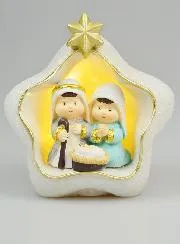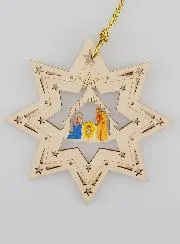The story of the Nativity, which celebrates the birth of Jesus Christ, is one of the most significant stories in Christian tradition. Yet over the centuries, this biblical account has been enriched by cultural elements and popular traditions which, although not explicitly mentioned in Scripture, have become an integral part of Christmas celebrations. This article explores in detail the biblical origins of the Nativity, its symbols, as well as the evolution of the popular traditions surrounding it.
The biblical account of the Nativity: a dual perspective
The Nativity is mainly told in the Gospels of Matthew and Luke. Although they both recount the birth of Jesus, these two accounts emphasise different elements, reflecting the theological objectives specific to each evangelist.
Matthew's version: the Magi and the star
In the Gospel according to Matthew, the emphasis is on the royal recognition of Jesus from the moment of his birth. The key elements of this narrative are:
The visit of the Magi: Guided by a star, these wise men from the East bring Jesus royal gifts - gold, frankincense and myrrh - symbolising his kingship, divinity and future sacrifice respectively.
The flight into Egypt: Matthew mentions the threat from Herod, King of Judea, who orders the massacre of children under the age of two, and the Holy Family's flight into Egypt to escape this danger.
This story insists on messianic prophecy, presenting Jesus as the king awaited by Israel, but rejected by the powerful.
Luke's version: shepherds and simplicity
The Gospel according to Luke adopts a more humble and accessible point of view:
The Announcement to the Shepherds: Unlike Matthew's Magi, it is shepherds, modest figures in Jewish society, who are the first to hear the news of the Saviour's birth.
The cot and manger: Jesus is born in a stable, symbolising the humility and accessibility of God becoming man.
Luke puts forward a universal message: the birth of Jesus is good news for everyone, including the humblest.
Key figures in the Nativity
Several emblematic figures play a central role in the story of the Nativity, both in the Gospels and in the traditions associated with it.
Mary: the Virgin chosen by God, she embodies humility and perfect faith. The Annunciation, when the angel Gabriel announces to her that she will bear the Son of God, is a key moment in the story.
Joseph: A carpenter and Mary's husband, he plays a protective role. Although discreet in the Gospels, he symbolises obedience and fidelity.
The angels: Messengers of God, they announce the birth of Jesus to the shepherds and sing, "Glory to God in the highest. "
The Magi: These foreign visitors represent the pagan nations' homage to Jesus, emphasising the universal dimension of his mission.
Biblical symbols of the Nativity
The Star of Bethlehem, the manger and the gifts of the Magi. The Magi's gifts have a deep spiritual meaning:
Gold: A tribute to the kingship of Jesus.
Incense : Used in religious rites, it emphasises the divinity of the Child.
Myrrh: A resin often used for embalming, heralding the suffering and death of Christ.
A luminous, celestial symbol, the star guides the Magi to Jesus. It is interpreted as a divine sign, announcing the birth of the Messiah. Mentioned in Luke's Gospel, the cot (or manger) symbolises the humility of the Son of God, who came into the world in simple conditions, far from royal palaces.
The evolution of popular traditions around the Nativity
The first representations of the cot: The tradition of the cot is attributed to Saint Francis of Assisi, in the 13th century. He is said to have created the first living cot in a grotto to make the story of the Nativity more accessible to believers. Since then, the cot, with its miniature figures, has become a central symbol of Christmas celebrations in many homes.
Christmas carols: the stories of the Nativity have inspired many traditional songs, known as carols. Tunes such as "Silent Night" or "Angels in our countryside" celebrate the birth of Christ and convey the message of peace and hope.
The representations of the Magi: while the Bible mentions only "Magi from the East", popular traditions have given them names - Gaspard, Melchior and Balthazar - and depicted them as kings of the three known continents (Europe, Asia, Africa), emphasising the universality of Christ's mission.
The Feast of the Three Kings: lfrom the episode of the visit of the Magi, this feast, celebrated on 6 January, commemorates the Epiphany, i.e. the manifestation of Christ to the nations. It is marked by traditions such as the galette des rois.
The theological and spiritual importance of the Nativity
Beyond the stories and traditions, the Nativity has a profound meaning for Christians. It is the starting point of salvation history, marking the Incarnation of God who takes on the human condition to save humanity.
The Incarnation of God: the Nativity reminds us that Jesus, although God, became man, fully sharing the human condition, with the exception of sin. This truth is at the heart of the Christian faith.
A message of hope: the birth of Jesus symbolises the light that illuminates the darkness of the world. It carries a universal message: peace, reconciliation and love are possible for all who accept Christ.
The story of the Nativity, told in the Gospels and enriched by centuries of popular tradition, is much more than a simple narrative. It is a celebration of the mystery of divine love, a message of humility and hope, and a reminder of God's presence in human life. The traditions that surround the Nativity, from the cot to the songs and family celebrations, extend this message, making it alive and accessible for every generation. May this story, blending biblical narrative and cultural richness, continue to inspire and enlighten our lives.




















